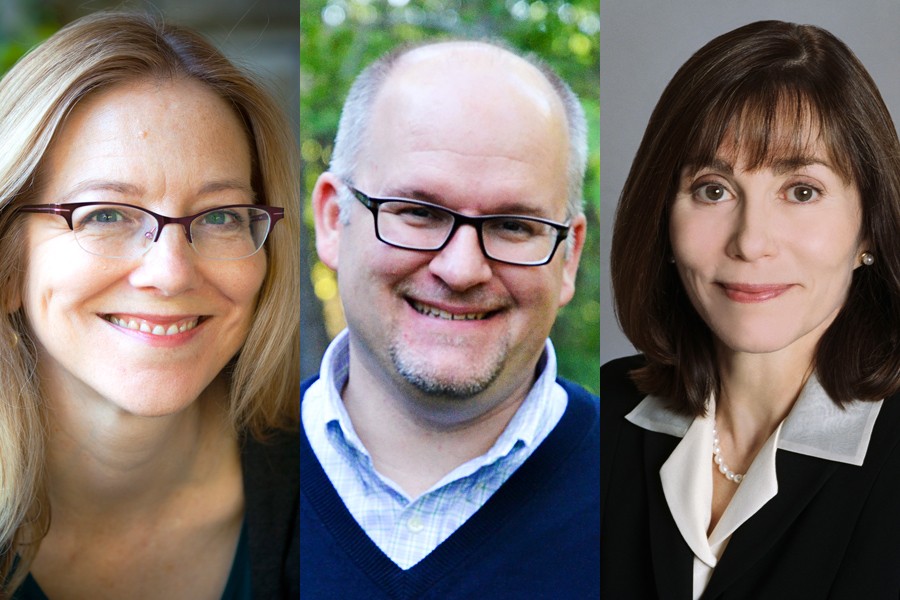Three world-class scholars—Stephen Morgan, Patricia Janak, and Kathleen Sutcliffe—will join the faculty as Bloomberg Distinguished Professors on July 1.
They are among a total of 50 cross-disciplinary professors who will come to Johns Hopkins over the next five years. These appointments, in addition to those of Peter Agre, Kathryn Edin, and Carol Greider, who were named to these prestigious endowed professorships earlier this year, bring the current number of Bloomberg Distinguished Professors to six.
"There's a lot of excitement about these people coming on board," says Barbara Landau, vice provost for faculty affairs. "We now have six Bloomberg Distinguished Professors, and there are already another 22 approved proposals. Soon the number of BDPs in place at the university will very rapidly increase. It's part of a much bigger trajectory, and that's really exciting."
Each professor will be a part of two or more schools, conduct interdisciplinary research aligned with the university's signature initiatives, and teach undergraduates as well as other students across the university.
Stephen Morgan, Krieger School, Sociology; School of Education
Sociologist Stephen Morgan says he "can't remember a time when I wasn't interested in education and inequality." It's the nexus of his research agenda: Which Americans choose to go to college, which succeed, and why? What role do social and economic institutions play? And is there anything policymakers can do to make sure we all have the same opportunities to succeed?
Morgan became hooked on these questions in 1991, when, as a junior at Harvard, he first learned of the now-famous Coleman Report. Commissioned by the U.S. Office of Education in accordance with the Civil Rights Act of 1964, the report reached groundbreaking conclusions that helped set in motion the mass busing of students to achieve racial balance in public schools. The study was conducted by James Coleman, founder of the Johns Hopkins Department of Sociology (originally the Department of Social Relations) and teacher of Aage Sørensen, the Harvard professor who introduced Morgan to the report. "From that day on, I was pretty sure I wanted to be a professor," says Morgan.
Today, Morgan studies predictors of student achievement, particularly how high schoolers' beliefs about the future affect whether they attend and graduate from college. He also is author of Counterfactuals and Causal Inference, a look at how social scientists can better study causal relationships. Because it's often impossible to design randomized studies in the social sciences ("for example, you can't randomly assign families to kids, for obvious ethical reasons"), these researchers must use specialized techniques to prove not just correlation but also causality. "If social scientists want to provide useful information to policymakers, we have to know how to speak and write carefully and precisely," explains Morgan, who was the Jan Rock Zubrow '77 Professor in the Social Sciences at Cornell University, where he also served for nine years as director of the Center for the Study of Inequality.
At Johns Hopkins, he'll be participating in the university's Institute for the American City, which draws together faculty members and students from across the university to develop and rigorously test solutions for the most pressing urban problems.
Patricia Janak, Krieger School, Psychological and Brain Sciences; School of Medicine, Neuroscience
Neuroscientist Patricia Janak studies the biological basis of behavior and associative learning, with a particular focus on addiction.
During her high school years in the late '70s and early '80s, scientists were "just starting to understand how chemistry can affect our thinking and our mood," she says. Fascinated, she signed up for all the college courses she could take in psychology and neuroscience. "It was the most fun thing that I was doing in college. This level of explanation—that how your brain functions is who you are—I wanted to learn more about that," she says.
In psychology, she discovered animal models of behavior and learning, and examined the neural circuits that might be important to those patterns. In neuroscience, she studied how neural circuits operate and change, and investigated related behavior and learning models. The two disciplines, she says, "are now poised to bring it all together. We can combine psychology's animal models of learning with the cutting-edge tools of neuroscience to really show how learning changes the brain."
Janak, currently a professor of neurology at the University of California, San Francisco, studies those changes in both normal learning scenarios and in pathological learning, such as drug addiction or post-traumatic stress disorder. It's a perfect tie-in to her future work in Johns Hopkins' Science of Learning Institute, an ambitious, cross-disciplinary effort to accelerate science-to-practice translation along the continuum of learning, from basic research in molecules and genes to the creation of effective public school policy.
Janak will be teaching graduate courses in psychology and neuroscience, and an undergraduate class on learning and memory as well. She has plans to bring together faculty from Psychological and Brain Sciences and Neuroscience who are interested in learning and reward mechanisms, and she's particularly excited about "the influx at Hopkins of top-notch younger scientists" in this field.
"The idea that there's a whole focus—and a lot of energy right now—at Hopkins on the science of learning drew me strongly," says Janak. "This is a great opportunity for growth."
Kathleen Sutcliffe, Carey Business School; School of Medicine, Armstrong Institute for Patient Safety
Organization theorist Kathleen Sutcliffe studies organizations and group decision making, with a special focus on reliability and safety, especially in health care. That academic emphasis stems from her background in nursing, the field in which she earned her bachelor's and master's degrees.
While serving as health director for Aleutian Pribilof Islands Association, one of the 13 Alaska Native regional corporations, she realized that she "was always thinking about organizations and not individuals. I thought, How can we make it better? I didn't want to run the organization, but I wanted to understand what goes into making it great."
Sutcliffe became fascinated with "high reliability organizations," such as aviation or nuclear power companies, which regularly avoid catastrophes in complex, high-risk environments. These organizations, she says, have several behaviors in common: They build a context of trust and respect, help people understand the larger goals of the system, recognize the small factors that might lead to failure, and establish flexible decision-making structures, among others.
"I thought this idea could be brought to other industries, especially health care," says Sutcliffe, who later earned her doctorate in organizational behavior and theory and has spent 20 years at the University of Michigan, where she was the Gilbert and Ruth Whitaker Professor of Business Administration and a professor of management and organizations.
Sutcliffe's first few papers on using "high reliability" approaches in health care, which she published with one of her doctoral students, showed that nursing units engaged in such behaviors made fewer medication errors and had fewer patient falls as well. She's gone on to study safety culture and has created a model for it that, she says, is more practical and useful than previous models.
Here, she will join the Individualized Health Initiative to help doctors improve treatment, testing, and prevention for their patients and will work with the School of Medicine's Armstrong Institute for Patient Safety "to use what we've learned from organizational theory to help create excellent health care institutions."










